On the Road to Plow Point Farms in Monroe, GA & a recipe for Armagnac Chicken
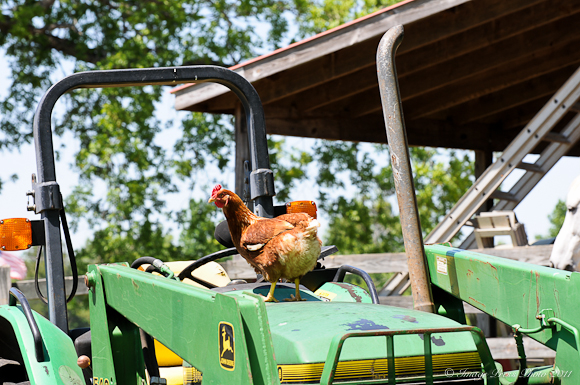
Chickens. I bet we eat chicken at least two times a week, if not more, in our house. We have become more concerned than ever about the chickens we eat, so we decided to go On the Road to meet with a small family farm that raises chickens, Plow Point Farms. Or as my husband Roger says, we went to visit the chicken ranch. 😉
Do you know that there are approximately 23 million chickens killed each day in the United States for food? Over 300 million chickens are raised and harvested in South Carolina alone on an annual basis. The numbers are staggering and you have to ask how we can possibly raise them fast enough. That is where most of us probably don’t want to know the story.

Photo from the internet
We pass many trucks hauling thousands of chickens to processing plants on our frequent trips to the mountains in North Carolina. Feathers are flying and the chickens are tightly packed in cages. The living conditions for most of these birds is horrific. As Chef Sean Brock (of McCrady’s and Husk restaurants in Charleston, SC) said in our interview with him, “Every time you buy food, you cast a vote. Here is my money, thank you so much for treating the chickens that way. Keep on doing what you are doing.” For this reason, Roger and I have made a conscious effort to support the locally grown and smaller farm-raised animals.
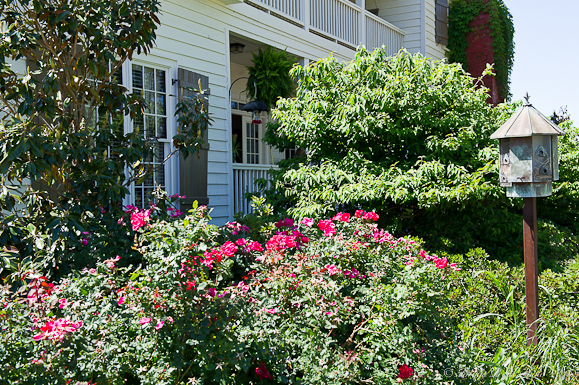
The farmhouse dates back to 1878
We met Robert Bishop of Plow Point Farms this past winter when we interviewed Chef Linton Hopkins of Restaurant Eugene in Atlanta. Robert was meeting with Chef Hopkins who buys several types of chickens and pheasant from this farm to serve at his restaurant. Several other chefs in Atlanta buy from Plow Point Farms as well, including Anne Quatrano from Bacchanalia.
After a rather long and cold winter, we made the visit to their farm near Athens, Georgia, this spring. Robert and his business partner, Russell Bennett, operate a 125-acre family farm that Russell’s family owns. They raise chickens, pheasants, cows and horses. They are also breeding and preserving several breeds of heritage rabbits. They practice pasture rotation to support the land and the animals.
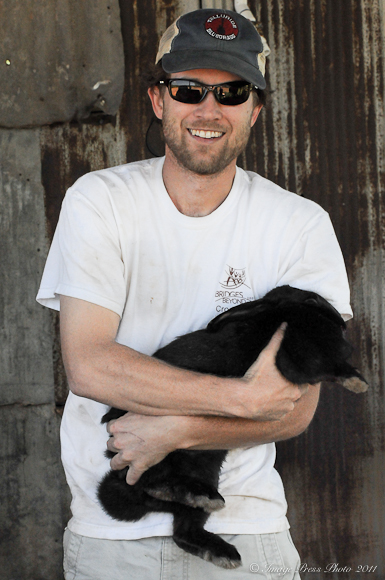
Russell with an American Black Heritage Rabbit
We had an opportunity to walk the pastures, although Nate the goat was not pleased with our presence and tried to butt us all around the farm. We learned that you don’t turn your back on Nate. Damn goat.
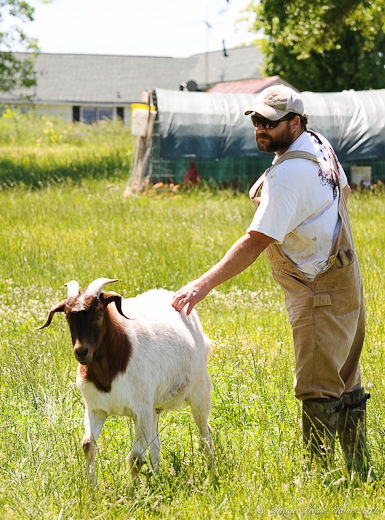
Robert is trying to keep Nate away from our butts
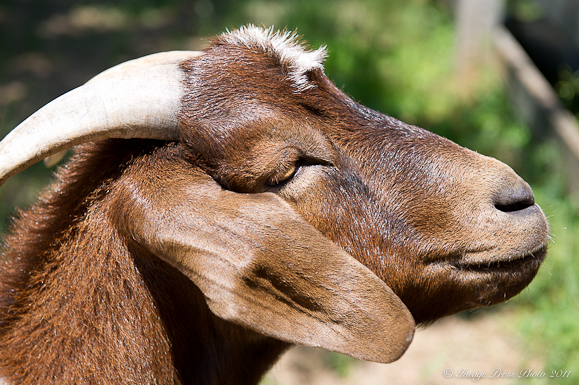
Don’t let this sweet face fool you!
Robert and Russell are friends from college. They both graduated from the University of Georgia about four years ago. They went into farming raising vegetables initially, selling them at local Farmers’ Markets. At the markets, Robert and Russell liked being able to barter for food. They could obtain fresh and local meats and poultry for their families. They eventually met someone at one of those markets that taught them how to raise chickens. It would be additional income and they could do this with the land they had.
Robert and Russell raise Freedom Ranger chickens for their meat birds. This heritage breed is derived from the genetic stock of an American and European old heritage breed of chicken and was imported from the regions of Burgundy and Brittany in France. It was developed in the early 1960’s and “meets the highest standards of the French Label Rouge Free Range program.” The meat has a very distinctive flavor. It is richer and moister than the regular chicken you would normally purchase (such as a Cornish Cross). Their birds taste just like the chicken we had while in France a few years ago.
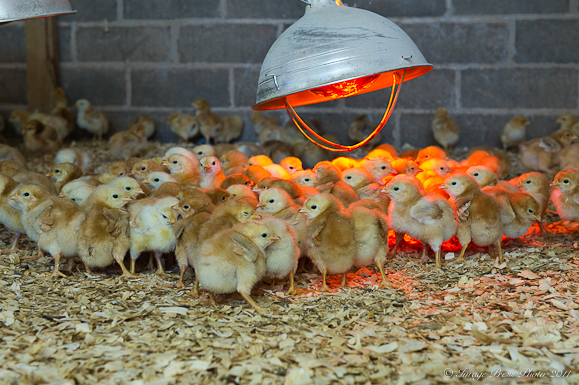
Freedom Ranger chicks in the brooder. They stay in the brooder until they are a bit larger.
This bird is heartier and bred to survive by foraging for grasses and bugs. Chickens like the Cornish Cross (the most commonly raised hybrid) could not survive a rain storm like these birds can. You would find many Cornish Cross dead after a storm. The Cornish Cross are also plagued with all types of defects after being so overbred in commercial hatcheries. The Freedom Rangers are born and bred to be raised outdoors, roaming free. The chicks that they purchase weekly are born in Pennsylvania Dutch Country and shipped to them. They will either raise them to a poisson (1 1/2 pounds) or a fryer size (3 to 3/12 pounds).
The poissons (or baby chickens), will take 4-5 weeks to grow to their desired weight and the fryers will take between 8-10 weeks. It is generally quicker in the summer when the grasses and bugs are plentiful.
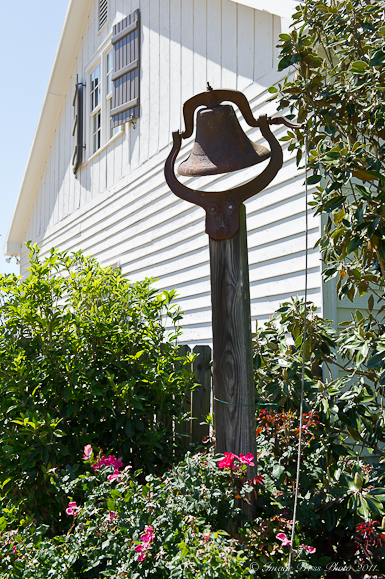
Compare this to the chickens that we purchase in our stores that weigh between four and five pounds. Many of these birds are raised in over-crowded spaces. Some are confined to individual small cages and harvested in under 40 days, while they are being force fed to grow quickly, often with antibiotics. Even companies that claim they use no antibiotics in the feed inject the eggs with antibiotics (before they are hatched), yet claim they are naturally raised. If you read the label on many of these birds, you will also see that they have been injected with a saline solution to pump up the meat even more.
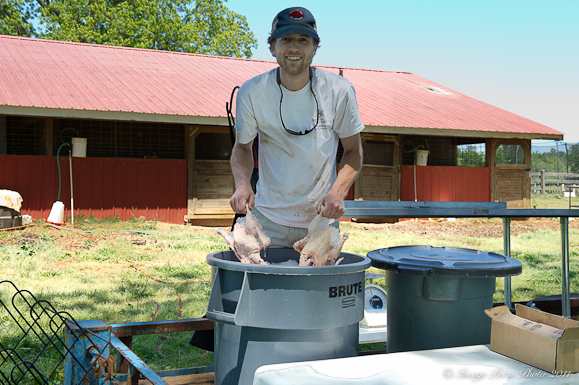
Russell and Robert process their chicken in a small area on their farm
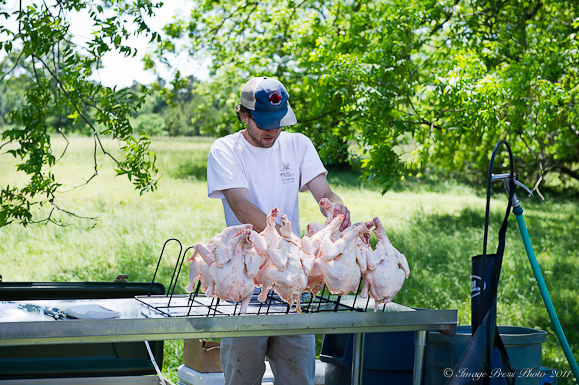
They process their chicken a few times a week
Plow Point Farms has 175 hens that lay about 70 dozen eggs a week. We were happy to take a couple dozen of those off their hands while we were there. 😉 The laying hens are Golden Comets which are a cross between a Rhode Island Red and a Delaware hen. We noticed that the eggs had a milder flavor than the ones I normally buy. The yolks were perfect and these were beautiful eggs to serve atop a special dish.
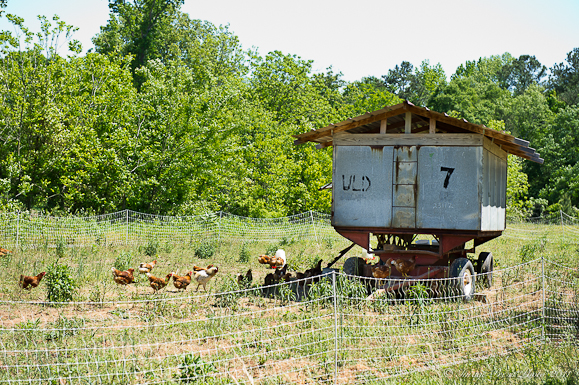
Their hen house rotates from pasture to pasture on the farm
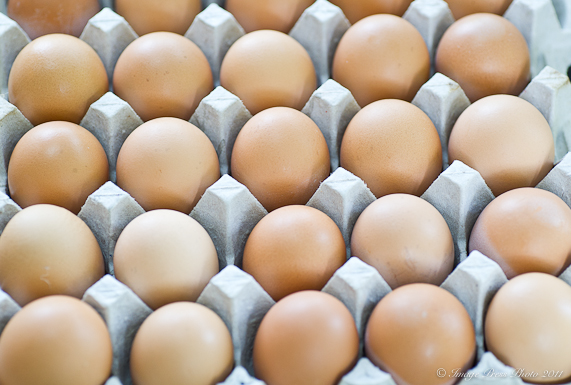
Eggs from Plow Point Farms
Many of the chefs that purchase chickens from Plow Point Farms are using the whole chicken, much in way that Chef Craig Diehl (of Cypress in Charleston, SC) is using everything but the squeal of the pig. These chefs are using everything but the cluck! Chef Linton Hopkins serves chicken heads at Holeman & Finch and other chefs are serving the feet and necks. They are also able to sell the organs for use in making stocks. There is very little waste from these birds.
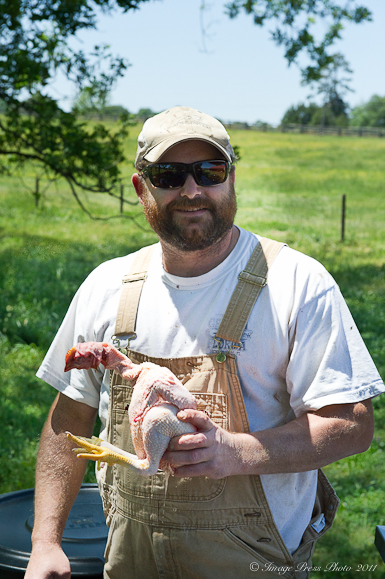
Some of the chefs use the entire bird
Robert and Russell are committed to enlarging their farm and are in the process of taking over Robert’s dad’s farm. They are hoping to raise more Black Baldy Cows (which are a cross between an Angus and a Hereford). They are also breeding and raising heritage rabbits. Both Robert and Russell are very fortunate in that they have inherited their family’s farms. If they had to purchase the land for their farming operations they would not be able to afford to buy it. n turn, we wouldn’t be able to afford to buy properly raised and harvested chickens. In addition, if the sons weren’t farming this land, it might have been sold to a developer or a corporate farming operation.
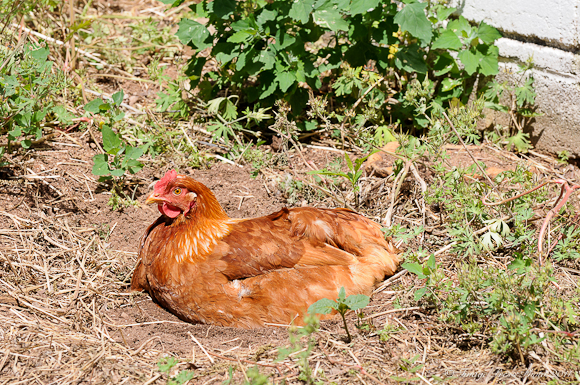
Are we laying an egg or just cooling off?
Holding a baby chick in your hands and then taking one of the processed birds home to prepare for dinner is a bit of a strange feeling. However, I would rather know where my food is coming from and see how it is raised. The flavor and the quality of their chickens and eggs from Plow Point Farms was exceptional.
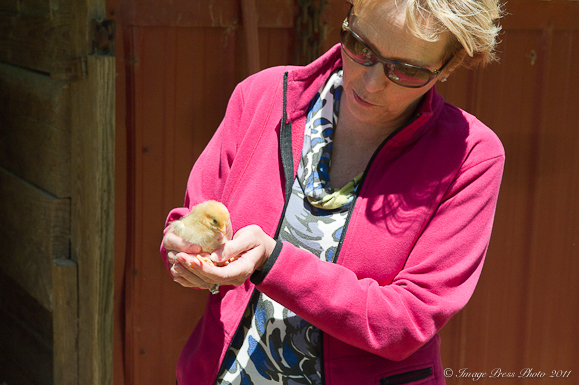
They are so cute as chicks
I realize that not everyone can go to a farm to buy a chicken for supper. We are certainly not able to do it on a regular basis either, but I always buy a bird that is organic and has been humanely raised and treated without antibiotics. Yes, it may cost more per pound, but we are casting our vote for the way we want our food to be raised and processed. If more people would make the switch, many of the large corporate chicken farms would have to change their approach.
This heritage breed chicken was worthy of a proper French dish, so I prepared Dorie Greenspan’s recipe for Armagnac Chicken. It is a simple meal that you prepare in one pot and let it cook on its own. The aroma of the Armagnac cooking with the chicken and the vegetables was intoxicating. The meat of this Poulet Rouge was perfect with these flavors.
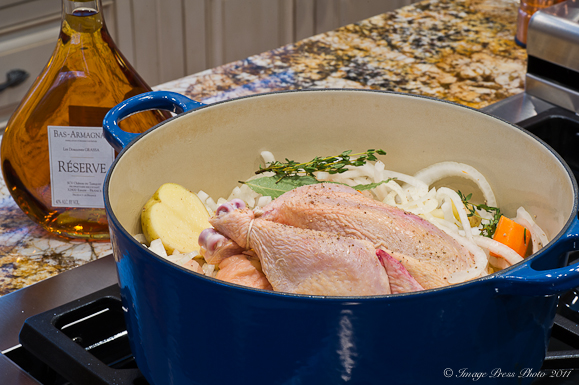
This is a delightful one pot meal
Armagnac is a bit of an investment, but since you only need 1/2 cup for the dish, you will have the rest of the bottle to enjoy as a digestif after your dinner with a dessert or save it for future cooking!
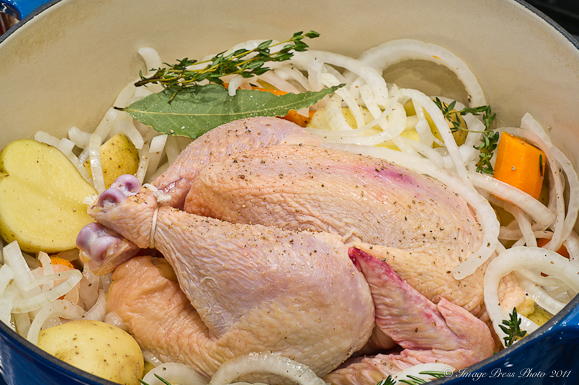
Put everything in the Dutch Oven and let it cook in the oven for almost an hour
We encourage you to support your local farmers. Know where your food comes from.
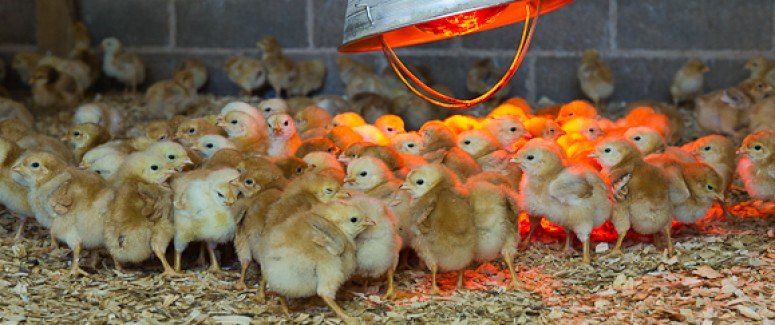
M. Jacque's Armagnac Chicken
Ingredients:
1 tablespoon olive oil or vegetable oil (I used olive oil)
8 small thin-skinned potatoes, scrubbed and halved lengthwise (I used white potatoes)
3 medium onions, halved and thinly sliced
2 carrots, trimmed, peeled and thickly sliced on the diagonal
salt and freshly ground white pepper (I used Kosher salt)
1 thyme sprig
1 rosemary sprig
1 bay leaf
1 chicken, about 3 1/2 pounds, preferably organic, trussed (or wings turned under and feet tied together with kitchen string), at room temperature
1/2 cup Armagnac (Cognac of other brandy) * Use Armagnac if at all possible. It imparts a very different flavor to the dish.
1 cup water
Directions:
Center a rack in the oven and preheat the oven to 450 degrees. You’ll need a heavy casserole with a tight-fitting cover, one large enough to hold the chicken snugly but still leave room for the vegetables. (I used a Le Creuset Dutch Oven.)
Put the casserole over medium heat and pour in the oil. When it’s warm, toss in the vegetables and turn them around in the oil for a minute or two until they glisten; season with salt and white pepper. Stir in the herbs and push everything to the sides of the pot to make way for the chicken.
Rub the chicken all over with salt and white pepper, nestle it in the pot, and pour the Armagnac around it. Leave the pot on the heat for a minute to warm the Armagnac, then cover it tightly – if your lid is shaky, cover the pot with a piece of aluminum foil and then put the cover in place.
Slide the casserole into the oven and let the chicken roast undisturbed for 60 minutes (Check temperature at 45 – 50 minutes. My chicken was done then.)
Transfer the pot to the stove and carefully remove the lid and foil (if you used it). Be careful to open the lid away from you, because there will be a lot of steam. After admiring your beautifully browned chicken, very carefully transfer it to a warm platter or a bowl; cover loosely with a foil tent.
Using a spoon, skim off the fat that will have risen to the top of the cooking liquid and discard it; pick out the bay leaf and discard it too. Turn the heat to medium, stir the vegetables gently to dislodge and that might have stuck to the bottom of the pot, and add the water, stirring to blend it with the pan juices. Simmer for about 5 minutes, or until sauce thickens ever so slightly, then taste for salt and pepper.
Carve the chicken and serve with the vegetables and sauce.
Around My French – Table Dorie Greenspan